Antennas for TV to the country
We are so accustomed to the flow of information that we feel insecure without it. Therefore, outside the city, having equipped more or less a house, the first thing to do is to have a TV. And in order for it to work in rural areas, a television antenna is needed for giving. It is selected depending on the location of the nearest repeater - TV tower and the type of TV signal that you will "catch".
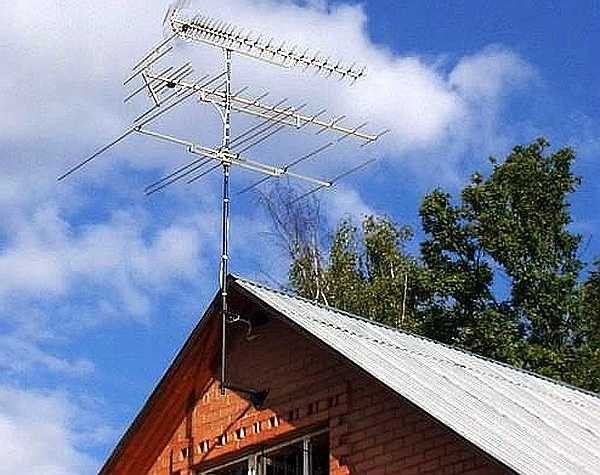
You can hardly see summer cottages without antennas
Today there are several types of signals, and accordingly, the same number of antenna types:
- Terrestrial analog television - the signal is encoded and transmitted in a certain wavelength range: UHF (decimeter waves), MV (meter). Terrestrial television antennas are most often seen in summer cottages. Although there are quite a few questions with them, they cost very little. If the dacha is seasonal, then most of the time you spend on the site, and you watch TV either in bad weather, or in the evening, when there is no longer an opportunity to work. Not everyone wants to install expensive equipment for several hours of viewing, and several channels that can “catch” such devices are quite enough.
- Satellite television. The signal is broadcast from the satellite, the quality is usually good, the number of channels is in the hundreds. But, dish antennas cost a lot. For good reception in rural areas, they must be large - at least 90 cm, which also affects the price. In addition, satellite broadcasting is paid, and they are charged for the year. There are inexpensive packages, it makes sense to buy them, if even in winter you periodically appear at the dacha. But in the case of satellite dishes in summer cottages, the question of their safety arises. If one of the neighbors lives permanently or there is good (!) Security, the equipment may survive. If not, it is better to dismantle it, and this is far from the easiest work.
- Digital television. The Russian Federation has adopted a program according to which by the end of 2015 the entire territory should be covered by digital television. If there is a tower near your summer cottage that broadcasts a TV signal in digital format, you can be considered lucky, using a conventional terrestrial UHF antenna and a set-top box (Set Top Box) with a DVB-T2 tuner, you can receive 20 channels in good quality. If you have a new generation TV that supports this format, then you do not need a set-top box, a correctly oriented antenna is enough.
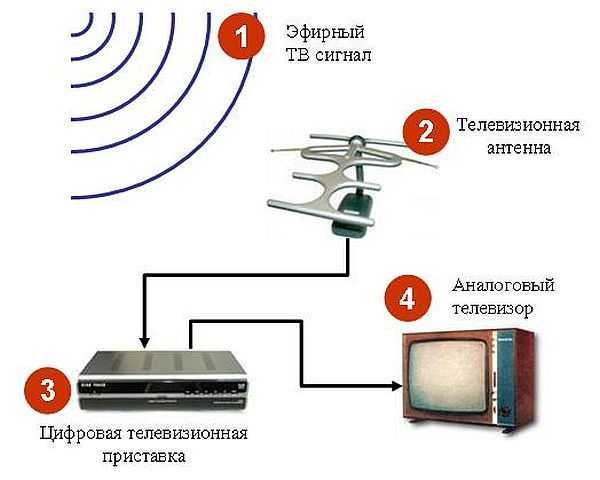
How to make an antenna for DVB T2 for giving (for receiving a digital TV channel)
The content of the article
Air TV antenna: what to choose for a summer residence
To say exactly what kind of antenna to put in your summer cottage can only be applied to each specific case. The choice takes into account:
- location - plain, hill, lowland;
- the presence or absence of forests and large trees near the house;
- distance to the nearest repeater.
The main thing is the distance to the TV tower and how much. height, you can raise the antenna. Sometimes every meter counts.
Indoor or outdoor
Indoor antennas can only be installed if the repeater is in your line of sight. If a TV tower is visible from your summer cottage, you can try. In order not to waste money, you can make the most simple antenna with your own hands: take a piece of wire, connect it to the corresponding TV connector, and walk around the room with this “antenna”, climb higher to the ceiling, closer to the window, etc. If at least some signals are caught, you can try make indoor antenna or buy.
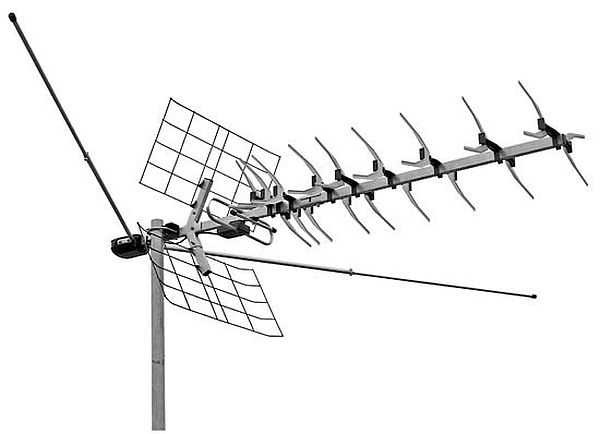
Outdoor antennas "catch" tens of kilometers from repeaters
If during all movements there are no signs of a clear signal, you need an outdoor antenna, but for a zone of reliable reception (with lower gain). For all other cases, when the distance to the tower is tens of kilometers, an external antenna is needed.
Broadband or narrow beam
Since terrestrial television is broadcast in two ranges - decimeter and meter, there are antennas for these ranges. If the receiver "catches" the signal in only one range, they are called narrowband. They are available only for UHF or only for MW frequencies.
There are also broadband (also called all-wave) - their design is designed so that it is possible to normally receive a signal at all frequencies. They are, as a rule, more bulky and heavy, have a long barbell. But they put up with it - a broadband TV antenna for a summer residence can "catch" more channels. Therefore, they are most often bought.
Active or passive
More attention should be paid to whether it is better to install an active or passive antenna. An active device is a device with an amplifier built into the body. Passive - these are only pieces of iron for which you need to buy an amplifier separately.
Active receivers with a built-in amplifier are cheaper, receive more channels, but they have a significant drawback: amplifier boards often break. Any more or less serious thunderstorm, and channels that were previously clearly received, begin to "snow" or disappear altogether. Replacing the board can help the trouble. To do this, you need to climb on the roof, remove the antenna, change the board, install and configure it again. This procedure can be repeated after every thunderstorm.
Even if thunderstorms did not affect the performance of your summer cottage antenna, still after a year and a half, the number of well-received channels decreases. The quality gradually gets worse, and sooner or later, you notice that it is no longer possible to watch. The reason is the oxidation of contacts and elements on the board. The receivers on the antenna are far from sealed and dust, moisture gets inside, destroying the contacts and tracks. Therefore, the average life of an active antenna is about a year. Not a thunderstorm, so oxidation will finish it off.
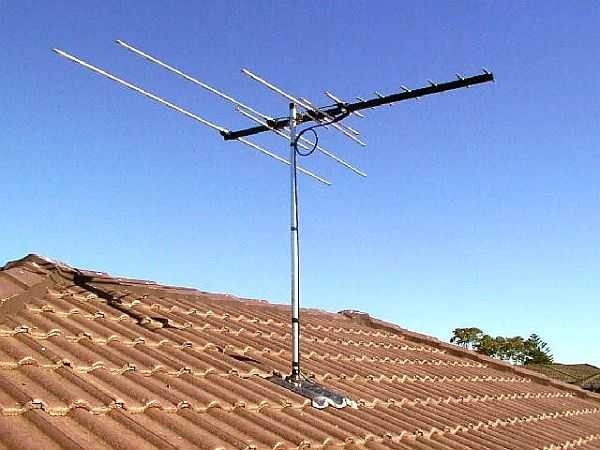
Best antenna for giving: inactive with a separate amplifier
There is nothing to help business with a thunderstorm, and oxidation can be significantly slowed down if you pour silicone on both sides immediately after purchase. This will protect contacts and elements from oxidation. Nobody will repair it anyway, if the board is “flying”, buy a new one and put it back in place. That's the whole repair. It is also useful to seal the cable connection point. Here, too, due to oxidation, there are large signal losses.
Passive antennas with separate amplifiers are good because the piece of iron is installed above the roof, and the amplifier is in the attic. Replacing the board in the attic is much less of a problem than on the roof. Especially in the winter. They "catch" fewer channels, but the picture is "cleaner".
There is one more plus: individual amplifiers have two adjustments - separately for the UHF range and MV. This is useful, because sometimes some signals come with a much higher level and they “block” weaker ones. Then there is an overlap of sound and / or image, in some cases, if some signal is very strong, it is generally snowing. By adjusting the sensitivity of the ranges, you can save the situation. So passive antennas with separate amplifiers for giving are the best choice.
Samsung and LG TVs generally have a “weak signal” function. In this case, you may not need an amplifier at all. Put a passive antenna in the country, turn on the mode, and tune the channels. It should be good to show at least 5-6 channels.
To ground or not
Another problem that needs to be addressed is whether the television antenna should be grounded for the summer cottage. On the one hand, this is often the highest point.On the other hand, if it is grounded, it will catch any lightning strike that is nearby. Accordingly, each time you have to change the board, as it will fail.
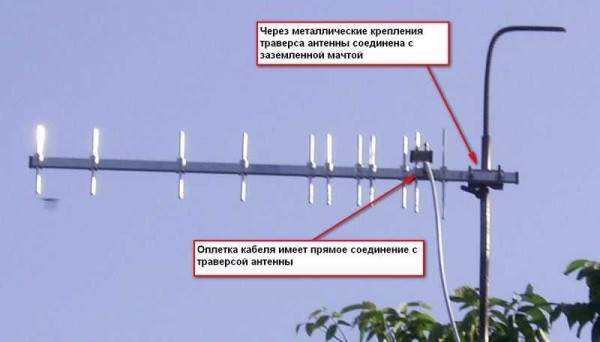
If you decide to ground the antenna anyway, attach the cable sheath to the metal rod and ground the rod
For this reason, "antenna operators" insist that they do not need to be grounded. Especially if the device is located below the power supply wires. Lightning will then strike the highest grounded point. The main thing is that it is not your antenna.
Which antennas are better
As usual, in addition to the type of equipment, you have to choose a manufacturer. And this, perhaps, is no easier. Recommendations can help. There are several popular manufacturers on the forums:
- Lokus (Locus). Antennas made in Russia. Wide assortment, low prices (from 480 rubles to 1.7 thousand rubles). There are both active - with a built-in amplifier, and passive.
- Harpoon. Also a Russian-made antenna. Accepts in the UHF and MW bands. They are produced only in passive form, intended for installation in areas of poor reception. Retail price - Harpoon-0416 - 1500 rubles, Harpoon-1028 - 2300 rubles.
- Antennas "Delta" manufactured by JSC "NPP OST". The assortment here is very wide. There are both narrow directional only for MV or only for UHF bands, and broadband. Moreover, UHF antennas can be used to receive a DVB-T2 digital television signal. Many models are equipped with an F-connector - a device through which the cable is connected: during installation, you do not need to disassemble it to connect it. Insert the stripped conductor into the socket. All. The cable is connected.
- GoldMaster (GoldMaster). There are few reviews, but according to the available ones, it accepts reliably even in the area of uncertain reception. Even when it rains, the signal quality hardly drops. The picture is still clear, without "snow".
All other manufacturers are not very popular.
For inactive antennas, amplifiers are also needed. There are also preferences here:
- House amplifier LHA;
- TERRA (Terra);
- Powerful amplifiers with low noise Breeze, Alcad (Alcad).
Antenna installation
Before starting all work, it is useful to grease all screws, nuts, antenna connections with "Movil" or "Litol", something similar in properties. If an active antenna is selected, it is better to seal the board with silicone. After such processing, the antenna will last not a year, but much longer.
About which cable to use for connection. It is better not to try to save money here: there will be too big losses. Therefore, take branded SAT 50 or SAT 703. The picture depends on the quality of the cable and the quality of the connections as much as on the reception.
TV antenna for summer cottages: where and how to install
The installation location is selected taking into account where you will need to point the antenna. If the roof and wind loads allow, it can be fixed on the roof. In order to raise the receiver higher, the antenna is attached to the mast. There are special clamps for this.
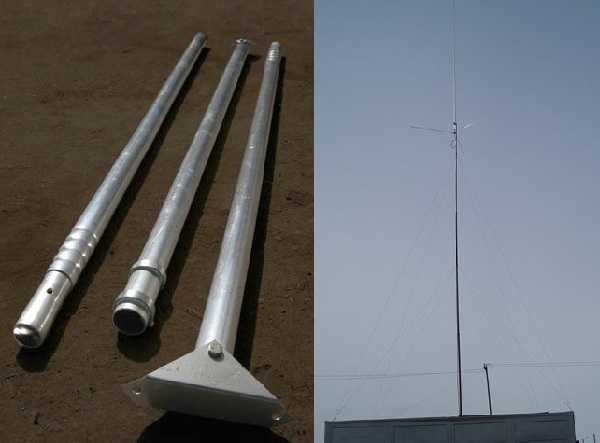
In some cases, you have to raise the antenna as high as possible - in lowlands or if trees block the reception. Then the telescopic rods come in handy.
There are metal prefabricated masts, there are telescopic masts - folding. This type is more convenient, especially if an antenna with a receiver - you will periodically need to change the board, and completely dismantling the mast every time is a pleasure. Telescopic masts can be lowered by unscrewing the locking ring. The top-mounted antenna will drop with the top of the boom.
If you do not need to raise it high, you can use a wooden bar or a skinned trunk of a young pine tree. This is a completely suburban option. You can use a small diameter steel pipe or an angle. Sea options. Selected supportneed to be fixed. Mounting methods are shown in the figure.
Most often, the antenna is mounted on the pediment. It is the easiest to implement, but only if the decoration or wall material allows.This does not fit on siding walls and on aerated concrete walls - too difficult. Then the option is to fix the bar to the pipe, to the rafters, or on the guy wires to the roofing material.
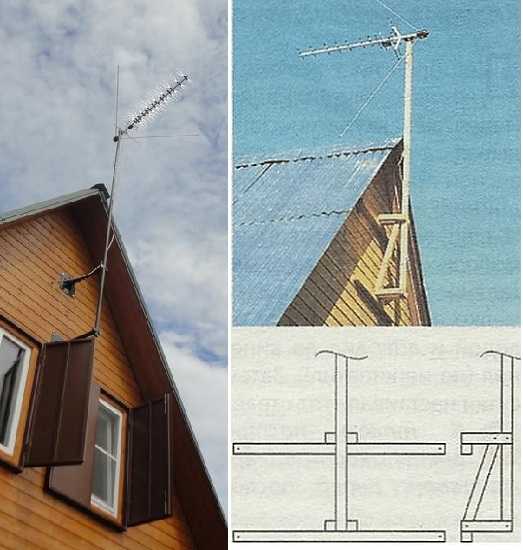
Methods for attaching the antenna to the gable of the building: made of iron and wood
When attaching to the pediment, the distance between the fasteners must be at least 1.5 meters. If none of these methods can be implemented for some reason, you can try to install the antenna on a powerful tree growing nearby. You can attach the antenna to the trunk and cut branches that interfere with reception. Sometimes this is the best way.
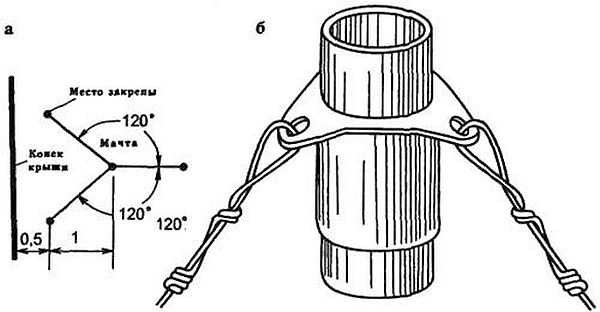
How to attach a barbell to stretch marks
Cable fixing
When installing the antenna, the cable is lowered down along the rod. It is fastened with clamps every 50-80 cm. Having lowered the cable to the level of the roofing material, it is brought along the ridge (so that the snow does not come off) to the bracket, with which it is lowered from the roof. The bracket is mounted above the window near the TV. The cable is brought into the room through a hole in the window frame. With an upward slope, a hole is drilled with a slightly larger diameter than the diameter of the cable. This prevents rain drops from entering the frame. The cable in front of the frame should sag a little - so we give freedom to temperature changes.
If the television antenna for the summer residence is inactive, the amplifier is installed in the attic, the cable from the antenna is led out to it, and from the amplifier to the TV.
One tip: when laying, sharp bends must be avoided. The minimum radius is at least 5 cable diameters. When fastening with staples, do not pinch it.
How to cut and connect antenna cables, see the video.

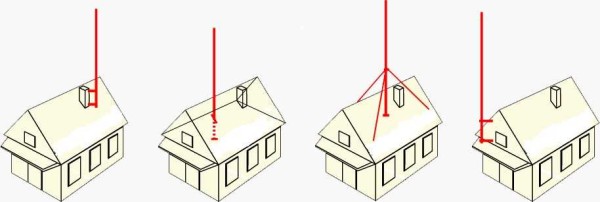
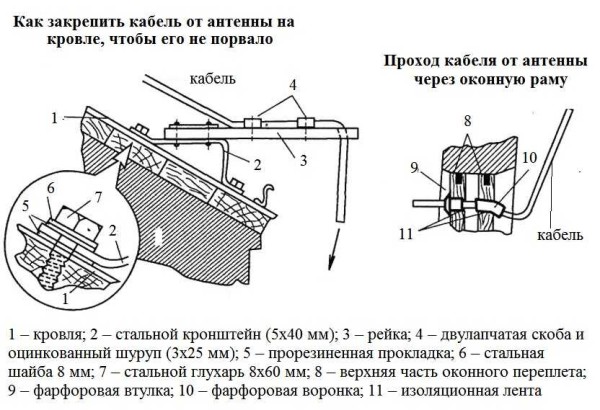


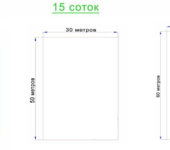







One question.
Pass the cable from the TV antenna inside a metal mast (pipes, rods) or outside, fixing it to the pipe.
The cable from the antenna to the rod is attached from the outside, you can use plastic clamps or pieces of wire. Place fasteners at a distance of 50-70 cm and in places of bends / turns. Do not pull on the cable, it should lie loose.
Even the best broadcasting antenna needs a quality cable and sometimes a good amplifier. Therefore, do not save and buy an imported cable, preferably Italian. But do not overdo it with an amplifier - it is super powerful, it can pick up "unnecessary" signals, on the contrary, worsening the viewing quality.
This antenna will be enough for a summer residence (50 km from the TV center). Or not to be greedy and buy something bigger and with an amplifier?
The characteristics say - confident reception up to 30 km. You have a TV tower 50 km away. If you put this antenna on, you won't really see anything even in good weather. Choose an antenna with a reception range (good reception) of at least 50 km. This one is rather weak.
HOW MANY TVs CAN I CONNECT TO THE DELTA ANTENNA I HAVE 3 WHICH ANTENNA CAN I CONNECT ALL LIVING IN THE GATCHINA
You can connect as much as you like. Buy an amplifier and splitter or active signal splitter.
<>
You are wrong, the receiver is specially placed next to the antenna with a weak signal, so as not to amplify what remains near the TV: signal loss in the cable and noise.Of course, it must be a special amplifier near the antenna designed for a large temperature range of -40 ... + 50C and specially protected from moisture, and it must be grounded against static electricity.
you need to install an antenna in the country